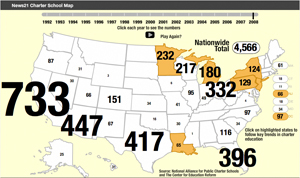Grade-Schoolers Learn Money 101
Sharon McCloskey | Jun 04, 2009 | Comments 59

By SHARON McCLOSKEY
DURHAM, N.C. - It’s Wednesday afternoon, and the usual collection of suits has gathered to discuss the past week’s revenues and assess the progress of their financial plan.
Board room? Rotary club? Stock exchange?
Not exactly.
This is the Carter Community School in Durham, N.C., and it’s grade-schoolers wearing those suits and dresses. And in this time of collective national anxiety over the state of our finances, these kids — ages 12 and younger — can probably teach us a thing or two about managing our money.
“By the time our kids are in third grade, they are learning to run the school bank and store,” said Gail Scott Taylor, principal of the Carter School. They’re learning more than just the basics of writing a check, too. They’re learning to appreciate the role of money in their lives.
“We’ll ask them, ‘Do you really need that pencil, or are you buying it just because you have money?’” said Taylor. “That kind of thinking has gotten us all in trouble.”
Educators and politicians alike now see an opportunity to teach from a crisis. In many classrooms around the country, first-graders are learning from Sammy Rabbit that saving is a habit. Middle-schoolers are managing bank accounts and high-schoolers are developing personal financial plans. In New Jersey, education officials are vetting changes in the kindergarten-through-twelfth-grade core curriculum, to require more comprehensive instruction of financial-literacy concepts. And Senate Majority Leader Steve Sweeney has introduced a bill launching a pilot program in select high schools throughout the state requiring financial literacy courses for seniors.
Long relegated to the role of proverbial football in the battle between proponents of a skills-infused curriculum, such as the Partnership for 21st Century Skills, and hard “core curriculum” advocates, such as Common Core, financial-literacy education has arrived.
Consider this: Fifty-three percent of high-school seniors have a debit card and 35 percent use a credit card, according to a 2008 survey by the Jumpstart Coalition for Personal Financial Literacy. Yet more than half of them can’t balance a checkbook and don’t know the basics about earning, saving and investing. Most haven’t learned about money at school, since only a handful of states require a personal finance course to graduate, and most apparently haven’t learned about money at home, either.

Buying snacks at the student-run store, Carter School (Courtney Morris/Carter School).
If crisis breeds opportunity, then could there be a more appropriate time?
“It is indeed a ‘teachable moment,’” said Robert F. Duvall, president of the National Council on Economic Education, a nonprofit organization that advocates for increased financial-literacy education in schools and develops instructional materials for that purpose. “None of us are born skilled in this area and, unfortunately, many of us have learned our money lessons the hard way.”
According to Duvall, interest in his programs has increased since the economy tanked last fall. “More calls are coming in about what schools can do to better prepare our young people with the basics of financial literacy so that they can succeed in life,” said Duvall.
Most states require the teaching of some financial concepts as part of a content-based curriculum, but they vary widely on specific standards and the testing for each. Many have not integrated financial literacy throughout the K-12 curriculum. And only 17 require a specific course for high-school graduation, according to a survey done by Duvall’s organization.
“Finding shelf space in an already-crowded curriculum is always a challenge,” said Duvall. “Infusion of personal finance and economic principles into other subjects is an effective way to ensure inclusion.” One example is a course called “Mathematics and Economics: Connections for Life,” which the Council designed with the help of the National Council of Teachers of Mathematics.
The infusion of financial literacy concepts across subject areas and grade levels changes how the content can be delivered. “We are really in the midst of a paradigm shift,” said Dale Schmid, coordinator of the New Jersey Department of Education’s Consumer, Family and Life Skills section. The battle is no longer about whether to teach financial literacy but rather how to include it in the curriculum, Schmid said. He has been traveling the state, explaining proposed revisions to New Jersey’s core curriculum and reassuring teachers that an MBA is not a prerequisite to teaching these concepts. “There’s lots of flexibility in how these lessons can be delivered,” said Schmid. “Many can be incorporated into language, math, history or other content areas.”
New Jersey’s revised curriculum makes personal finance a separate standard, requiring instruction in several areas including income, credit and debt, financial planning, saving and investing. It also sets clear markers for proficiency at grade levels. For example, by the end of fourth grade, students should be able to explain the difference between debits and credits and understand the consequences of each. By eighth grade, students should be constructing a short and long-term personal budget. And by twelfth grade, students should develop a long-term financial plan. New Jersey will also join New York in requiring completion of a half-year course in financial literacy for high-school graduation, beginning with freshmen entering in 2009.
Positive reaction to the curriculum may reflect the gravity of the economic crisis, said Schmid. “The times point to the need for a concerted effort to ensure that students are financially literate.”
But back in North Carolina, Gail Scott Taylor didn’t wait for a financial crisis or a state education mandate to decide it was time for the Carter School children to learn money basics.

Talking about goods and services in the second grade, Carter School (Courtney Morris/Carter School).
“This school sits across the way from a check-cashing store,” said Taylor. “All day long I’d watch the traffic in and out of that place, and I’d wonder, ‘do those people even know what’s happening to their money over there?’ Or why they’re going there in the first place?”
Determined that her students not repeat this cycle of financial illiteracy, she and her staff designed a program in which everyone, from kindergarten through eighth grade, participates.
Taylor has no time for the debate between skills and content, as larger life lessons loom. She wants to empower her students as consumers. That means ongoing conversations throughout the school day — not just during specific subject periods — about designer sneakers, hip-hop clothing, cell phones and the like.
“We teach the children to set goals and have vision, and to spend their dollars where they are valued, not where they are exploited,” said Taylor. “We want them to think about what their dollars are saying.”
Filed Under: New York City • Unchartered Territory
About the Author:














[...] Knocking on the Glass Ceilings by Josannah Birman. Text, photos, soundclilps, links. [...]
[...] IN BRIEF Much can be learned from a crisis. This story, “Grade-Schoolers Learn Money 101,” explores how the state of our economy has forced many of us to confront this uncomfortable truth: [...]
Hi there, I was just wandering the world wide web and came across your site . Thought I’d say thanks and tell you that I’ve enjoyed my stay here, hope you have a wonderful evening !
Hi , wircklich interessanten Blog besitzt du . Ich selbst habe schon länger eine eigene Site hochgeladen, eine Such-Maschine. Im Moment noch zu finden bei beta.jerome.de. Währe nett wenn du mir antwortest was du von ihr hälst und was vielleicht noch nicht so gut dabei ist. Ein Design kommt erst im Laufe des Tages dazu. Schönes Wochenende - 345zhf4
Интересно, но все равно остается вопрос . А, зачем? бы пересмотрел то,
That’s interesting, but I I like graffiti characters better but hey whatever works for you, it’s all graffiti right?
Intimately, the article is really the freshest on that worthw hile topic. I suit in with your conclusions and can eagerly look forward to your coming updates. Simply saying thanks will certainly not simply be acceptable, for the fantasti c lucidity in your writing. I will certainly correct away grab your rss feed to stay abreast of any kind of updates. Genuine work and much success in your business efforts!
Hey I was just wondering do you do all the writing yourself or do you have guest posters. I’m loving your blog. Thanks.
Great post. I remember my school days. Ooh so many years pass.
john scott
She does have a nice body none the less.
Hey I just wanted to let you know, I actually like the piece of writing on your site. But I am employing Firefox on a machine running version 9.04 of Xubuntu and the look and feel aren’t quite satisfying. Not a serious deal, I can still essentially read the articles and explore for information, but just wanted to inform you about that. The navigation bar is kind of tough to apply with the config I’m running. Keep up the great work!
-Sterling Stayner
Сайт супер, буду рекомендовать друзьям!
Я писал что-то подобное, но у Вас тема более глубого раскрыта
Without sounding like I am stating the obvious I assume that you are trying to teach us bloggers something with this post . So I will say what I have learned and APPLIED from reading this site and this post.
I like the idea, but these children really need to be learning core fundamentals such as grammar and math. Adding dollars and cents will not make great teachers, doctors or scholars.
I think i like this post, i believe its informative to our audience. so much things to use and i hope you regularly write very good stuff on this website. thanks for sharing
разместил на своем народовском сайте ссылку на этот пост. думаю, многим будет интересно!
где можно вашу аську увидеть? хотела бы пообщаться.
Thanks for this post, answers a bunch of questions I was having.
tradeking
Great info about childreens. Like that reading.
thyroid imbalance
Useful info. Great article
По моему у Вас украли эту статью и поместили на другом сайте. Я её уже видела.
Is this used as a quit smoking aid?
Thanks for sharing such an insightful article with all of us. I’ve bookmarked your blog will come back for a re-read again. Keep up the great work.
I following your blog for some time now and i like it alot. But how do i subscribe to your blog?
Dorsey Kahae
10 tips on how to look pretty
Stick to it experts say it takes about 21 days for a new activity such as exercising, to become a habit, and a full 6 months for it to become part of your natural behaviour.
Stick to it experts say it takes about 21 days for a new activity such as exercising, to become a habit, and a full 6 months for it to become part of your natural behaviour.
Dont make resolutions after a few drinks, this is not a good move.
Very good information for all
Super article.
Like you article
Great post. Find more about children in my site
Nice post. I like it.
Hey Nice Info. Keep update it.
Nice info. I like you style of writing.
Seriously! Beautiful
You make some good, valid points, but I can’t say that I agree with you completely on this one.
Hey friend I’ve really loved reading up your post I’ve found them really interesting, Can’t wait for your next post! Speak again soon =]
Online currency trading in forex trading has numerous benefits in store. It really is featured with true time accessibility, non stop availability etc. It helps a trader to trade at the comfort of his personal home and move according the situation from the current market. Forex is the largest trading current market within the world.
We choose our joys and griefs long before we experience them.
Thank you so considerably for that extraordinarily earliest class editorial!
Thanks for posting this article. I’m definitely frustrated with struggling to search out relevant and brilliant commentary on this subject. Everybody now goes to the very far extremes to either drive home their viewpoint that either: everyone else in the planet is wrong, or two that everyone but them does not really understand the situation. Many thanks for your succinct, applicable insight.
This is a awsome resource for home techniques. Im glad I got to this site. I was looking bing for sites similar to my website. Im a big fan of all sorts of do it yourself projects, and home improvement projects. I hope you check out my blog as well. thanks!
Excellent site. It was pleasant to me.
Hey just came across your site and I like it alot. I have my own seo website and I am always ready to learn more about it. Keep up a good work.
But you may not want to put longer-term savings here. These are where a lot of people stash extra cash, but they are not wise vehicles for savings.
I recall my english teacher spending multiple classes explaining how an Roth IRA works and showing the class the magic of compounding interest.